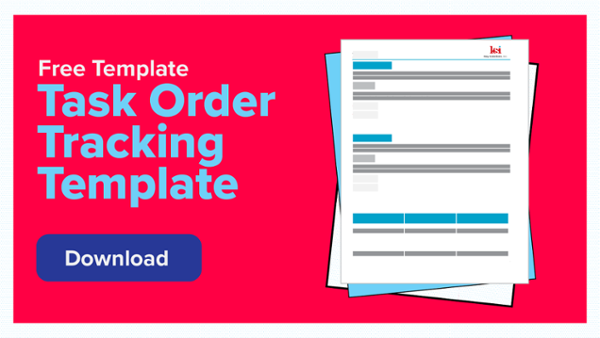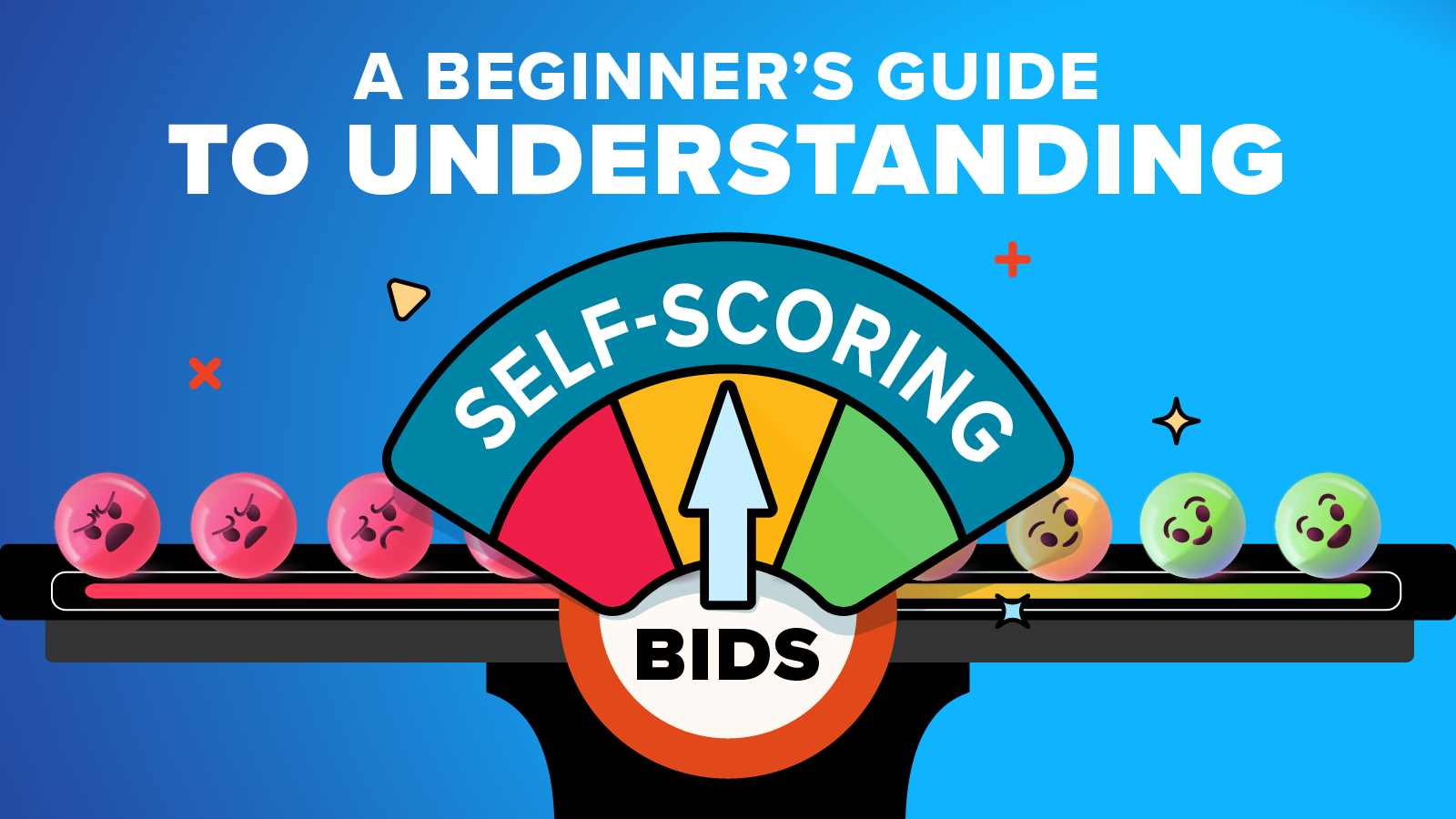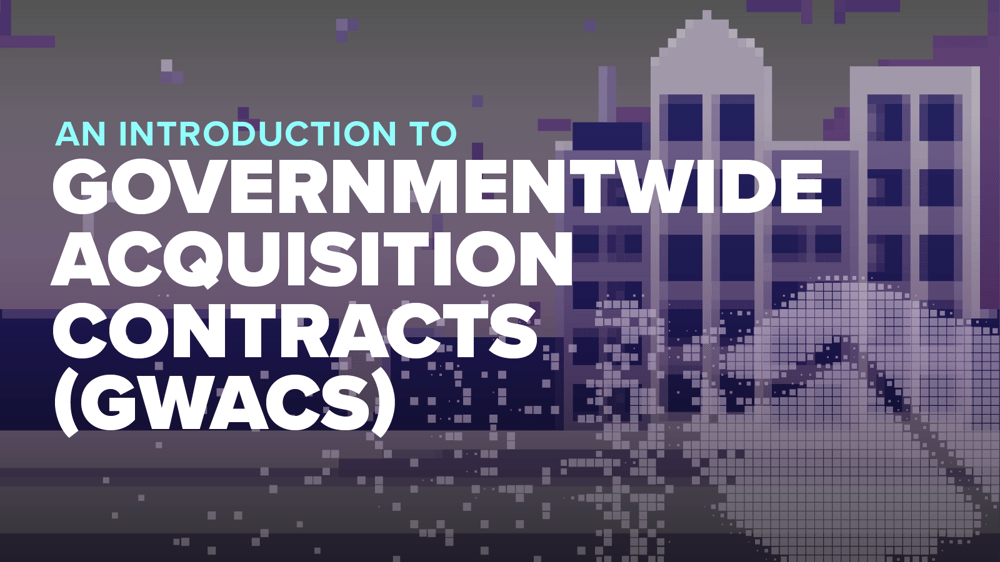
Within the world of US Federal Government Contracting, it is easy to become overwhelmed with all the acronyms that get thrown around. One acronym you might have come across is GWAC.
What exactly is a GWAC?
GWAC stands for Governmentwide Acquisition Contract, and a GWAC is simply a special type of multiple-award, Indefinite Delivery Indefinite Quantity (IDIQ) that federal government agencies can use to buy information technology (IT) solutions.
What sets GWACs apart from other Multiple Award Task Order Contracts (MATOCs) is that GWACs are established by one federal agency for governmentwide use; they are operated either:
- by an executive agent designated by the Office of Management and Budget (OMB) pursuant to section 5112(e) of the Clinger-Cohen Act, 40 U.S.C. 1412(e); or
- under a delegation of procurement authority issued by the General Services Administration (GSA) prior to August 7, 1996, under authority granted GSA by the Brooks Act, 40 U.S.C. 759 (repealed by Pub. L. 104-106).
IDIQs and MATOCs Explained
IDIQ contracts serve as vehicles under which contract holders bid and may be awarded multiple future contracts. These future contracts are called task orders for services and delivery orders for products. When the Government awards an IDIQ, it does not know how much of a specific product or service it will need over a defined period of time. Accordingly, the IDIQ contract vehicle provides the Government with the flexibility to order as much—or as little—of the products and/or services it ends up needing over the life of the contract, as long as those amounts are within the pre-negotiated minimums and maximums (see Federal Acquisition Regulation (FAR) 16.504).
Under a multiple award IDIQ, multiple awardees are chosen to provide services within a pre-defined dollar amount. Awardees consist of a pool of contractors who compete for subsequent task orders.
Through GWACs, the federal government can buy cost-effective, innovative solutions for IT requirements.
Best-In-Class (BIC) GWACs by Agency
GWACs are a key part of the OMB’s category management strategy. Accordingly, federal government agencies are encouraged to use GWACs that have met OMB's Best in Class (BIC) criteria because they adhere to rigorous requirements definitions, include appropriate pricing strategies, and provide supporting data to measure and manage performance. Below is a listing of BIC GWACs by agency. ![]()
NASA
According to an article written by Chris Riotta of FCW, NASA was the pioneer of the GWAC in the early 1990s, when they set out to streamline their acquisition process through an innovative pilot project for a then experimental approach applied to what they called Solutions for Enterprise-Wide Procurement (SEWP). Now in its fifth iteration, NASA's SEWP has always had the lowest fee of any GWAC, starting at 2.6% in 1993 and dropping to the current rate of 0.34%.
SEWP V: This program has a $20 Billion ceiling per contract holder, each with a five-year base period and one five-year option period; it covers commercial IT products and services.
GSA
Through pre-competed GWACs, GSA enables informed decisions while evaluating, purchasing, and implementing technology. They work with leading industry partners and each government agency’s in-house contracting professionals to maximize operational effectiveness and efficiency while minimizing acquisition risks. GSA BIC GWACs include:
8(a) STARS III: This 8(a) small business set-aside contract has a $50 Billion ceiling with a five-year base period and one three-year option. The vehicle provides flexible access to customized IT solutions.
VETS 2: The only GWAC set aside exclusively for Service-Disabled, Veteran-Owned Small Businesses (SDVOSB), this contract has a $5 Billion ceiling with a five-year base period and one five-year option. The contract supports diverse IT services requirements, including new and emerging technologies.
Alliant 2 (A2): This contract has a $75 Billion program ceiling with a five-year base period and one five-year option. The scope covers artificial intelligence (AI), distributed ledger technology (DLT), robotic process automation (RPA), and other types of emerging technologies. The Alliant 3 Request for Proposal (RFP) will be solicited no earlier than the First Quarter of Fiscal Year 2024 (Q1, FY24), to provide the Government sufficient time to review public responses to Requests for Information (RFIs).
Complex Commercial SATCOM Solutions (CS3): This contract has a $2.5 Billion ceiling with a five-year base period with one three-year option period and one two-year option period. The scope covers large, complex, custom satellite solutions, including services and components.
Enterprise Infrastructure Solutions (EIS): This contract has a $50 Billion ceiling with a five-year base period and two five-year option periods. The scope covers IT telecommunications and infrastructure requirements.
OASIS and OASIS Small Business (SB): These contracts have no program ceiling and boast a five-year base and one five-year option. The contract scopes cover professional services, including program management, management consulting, logistics, engineering, financial, and scientific services. On 6/15/2023, GSA’s Office of Professional Services and Human Capital (PSHC) released the final request for proposals (RFPs) for the OASIS+ Multi-Agency Contract (MAC) on SAM.gov.
National Institutes of Health Information Technology Acquisition and Assessment Center (NITAAC)
The National Institutes of Health Information Technology Acquisition and Assessment Center (NITAAC) is one of three Executive Agents designated by the Office of Management and Budget (OMB) to administer Government-Wide Acquisition Contracts (GWACs) for information technology (IT). NITAAC BIC GWACs include:
CIO-SP3 and CIO-SP3 Small Business: These contracts have a $20 Billion ceiling per contract holder and a 10-year period of performance; the period of performance has been extended to 4/29/2023, with a task order period of performance (POP) through 4/29/2028 to ensure coverage as CIO-SP4 is awarded. This contract provides IT services and solutions. The follow-on contracts, CIO-SP4 and CIO-SP4 Small Business, will be awarded in 2023.
CIO-CS: This contract has a $20 Billion ceiling per contract holder with a five-year base period and one five-year option period. The contract scope focuses on innovative and secure commodity solutions for agencies across the federal government and initiatives such as cloud computing, cybersecurity, and mobility.
Why Are GWACs Appealing?
GWACs are appealing to the Government because they create a smaller, down-selected pool of contractors from which to solicit work via task orders or delivery orders. Because a single agency administers them for a relatively small fee, they typically help agencies buy total IT solutions more efficiently and economically.
Although GWACs originated to support IT solutions, GSA recognized the need for agencies to have a streamlined way to procure non-IT services. Because of this, GSA created OASIS, which consists of standardized labor categories and allows for all contract types at the task order level.
GWACs provide government agencies with some protection against protests. Under GWACs, contractors cannot protest task order awards under $10 million issued by civilian agencies and under $25 million issued by agencies under the Department of Defense.
For similar reasons, winning GWACs is appealing to contractors. These vehicles reduce the number of competitors, increasing the company’s odds of winning from the start. This down-selected pool also helps to pre-focus the company’s competitive analysis activities.
How Do You Win a Seat at the Table?
The key thing to remember about GWACs is that you need to secure the vehicle before you can compete for the subsequent task orders. Most GWACs have a period of performance of 5 to 10 years, so it’s critical to identify your must-win GWACs well in advance of the solicitation release. You should meet with the customer to understand their goals with the contract, their potential acquisition strategy, and any issues and hot buttons they may have related to the work.
Then work to understand any of your company’s capability gaps, and if allowable under the procurement, form a team to address those gaps in your proposal. When forming your team, also consider whether any small business goals will be required under the contract. Use these capture activities to develop a solid overall solution and proposal plan.
GWACs are appealing to contractors because they create a smaller, down-selected pool of contractors, reducing the competition, and thereby increasing the company's odds of winning from the start.
Once the Request for Proposal (RFP) is released, respond to the solicitation just as you would any other large, standalone RFP. Focus first on compliance and then weave in the necessary proof points and details to present a compelling and winning proposal. Make time for iterative reviews and ensure your price is on point. Invest the right time and resources to put your very best foot forward, as your next chance to secure a seat at the table might not be for five or ten more years!
You’ve Won a GWAC. What’s Next?
Winning the GWAC is just the first step. Once you win a seat at the table, you need to make sure you are marketing the GWAC with your existing customers. Let them know the benefits of leveraging the GWAC for upcoming new opportunities and recompetes: simplified procurement, minimized protest risk, low fees, etc.
Additionally, you’ll need to set your company up with a solid task order process if you don’t have one in place. How often do we see companies spending good time and money on winning a GWAC vehicle but then fall flat on the task order responses? That is why setting up a solid response process is so critical.
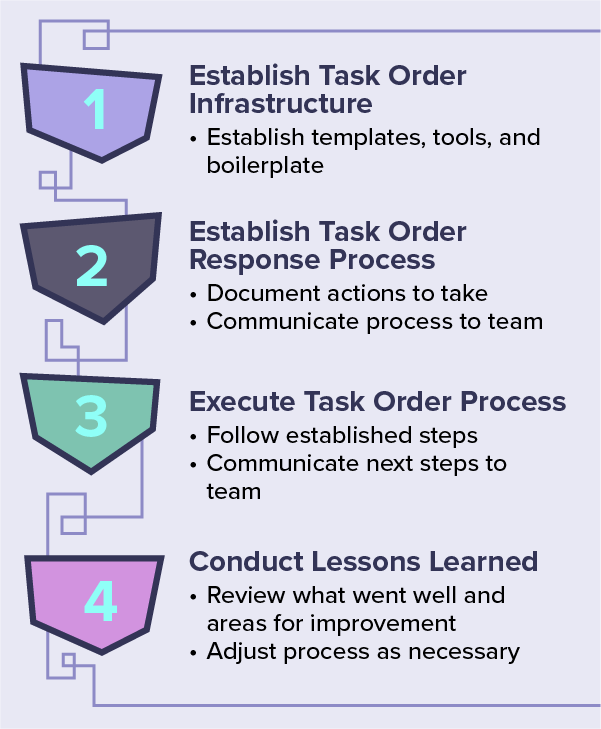
1. Establish the Task Order Infrastructure
The typical task order turnaround is 10 days, so it’s critical that you set up the necessary infrastructure to support an agile response process. When setting up your task order response infrastructure, the first thing you’ll need to do is establish your forecasting and capture function. Understanding when the task orders are expected to be released will help you to prepare for the response in advance and will help prevent the mad scramble that so many companies have become accustomed to.
Once you have the task order pipeline established, you’ll want to review the pipeline regularly with your team. Identify the must win task orders and focus your capture efforts on those targeted opportunities.
Next, you’ll want to establish your response hierarchy within your proposal management tool, for example SharePoint, Privia, or Virtual Proposal Center. One best practice to follow is to create a main workspace for each IDIQ with sub-workspaces for each task order response. At the IDIQ level, you’ll want to include key resources, including the IDIQ Contract, the IDIQ proposal, sample past performance write-ups, boilerplate sections, task order templates, and sample graphics. For each task order response workspace, you’ll want to include folders organized to support your task order response process.
These folders include Solicitation Documents, Reference Materials, Capture Management, Proposal Management, Working Drafts, Review Files, Production, Graphics, and Final Submitted Files. Your response library should include key proposal management resources within the Proposal Management folder. These include sample schedules for common response turnarounds (including 5-day, 10-day, 20-day, and 30-day turns), questions templates, points of contact lists, compliance matrix templates, review templates, and blank task order templates.
IDIQ Response Hierarchy 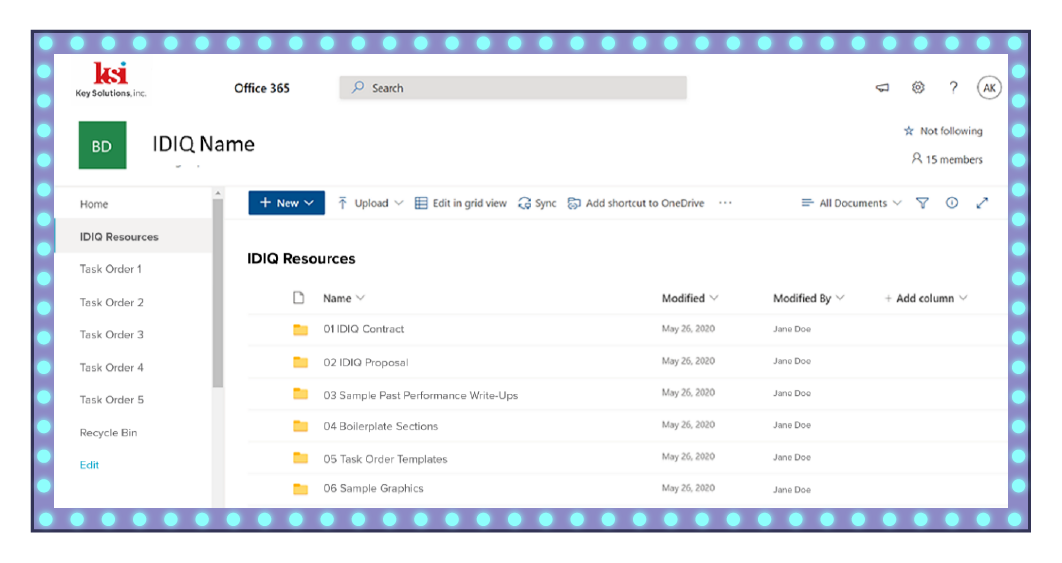 Example One: Main IDIQ Workspace with Sub-Workspaces for Each Task Order Response
Example One: Main IDIQ Workspace with Sub-Workspaces for Each Task Order Response
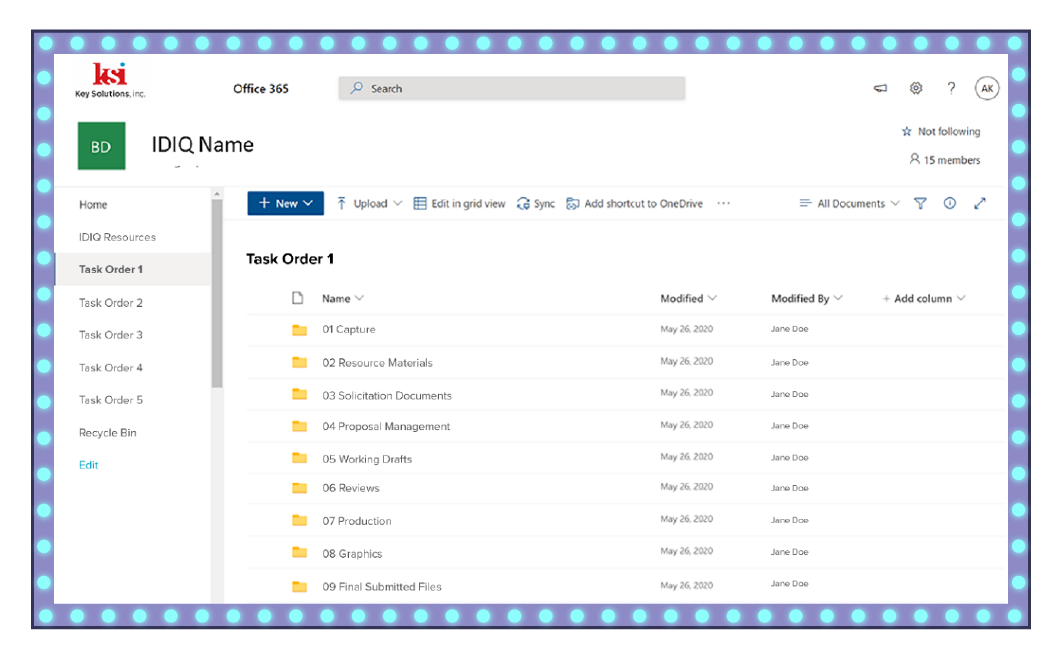 Example Two: Task Order Response Sub-Workspace
Example Two: Task Order Response Sub-Workspace
Set Up Your Templates. Because the format requirements generally remain consistent from task order to task order, having pre-set task order templates ready before the RFPs drop will save you so much time. Your templates should include editable covers with placeholders for required information, editable headers and footers also with placeholders for required information, as well as built-in styles set to meet common task order RFP requirements. At a minimum, set these built-in styles for headings, body text, bullets, table text, table bullets, figure titles, and action captions.
To further streamline your task order templates, I recommend pre-outfitting the templates with headings mapped to the most common task order requirements. Under each major requirement, drop in boilerplate that can be adjusted quickly with find and replace. Also include editable callout boxes as reminders for your team to add in relevant proof points and success stories. Additionally, make sure you include placeholders for common graphics, including organization charts, quality graphics, process flowcharts, risk matrices, and schedules.
Establish Solid Boilerplate. You’ll also want to include boilerplate or reuse sections in your response library. These should be specific to the typical task order requirements, but will likely include cover letters, executive summaries, corporate capabilities, past performance write-ups, management plans and/or approaches, subcontracting plan and approach, technical approaches, and pricing approaches. For each of these areas, include content commonly asked for in the task order RFPs. For example:
- For past performance, you’ll also want to maintain an up-to-date list of internal and external points of contact such as, project managers, technical points of contact, and customer points of contact.
- Your management plan and/or approach might contain reuse content related to your project organization, transition approach, staffing approach, quality approach, safety measures, risk mitigation and management, schedule management, and cost controls.
- For pricing, you might include your cost accounting systems and standards, descriptions of your purchasing systems, descriptions of your estimating systems and procedures, Defense Contract Audit Agency (DCAA) and Defense Contract Management Agency (DCMA) Points of Contact (POCs) and any audit results, and any forward pricing rate agreements you may have in place.
Having strong boilerplate in place will help you to respond to task orders more efficiently because the baseline content is already prepared. To facilitate even faster responses, include the most common boilerplate directly in the templates and other less common reference material as content to be inserted as required. I recommend leaving customer names out of your boilerplate to reduce the chances of accidentally leaving the wrong customer name in your task order response. Instead, replace customer names with the highlighted word <CUSTOMER> in all caps with carats. This will facilitate easy find and replace and help prevent incorrectly replacing generic references to customers.
Mad Lib Style Theme Statements. It is also helpful to include “mad lib- like” theme statements for your major sections. For example, in your transition section, you might include something like the following:
To support a successful and low risk transition for CUSTOMER, our Transition Manager brings X years of experience transitioning projects of similar size, scope, and complexity to TASK ORDER NAME. This includes successfully transitioning more than X personnel onto the $X million contract name in fewer than x days/weeks/months.
Proof Points List. In addition to maintaining narratives that can be tailored for each task order, it’s also helpful to keep a list of relevant proof points and facts that can be dropped into boilerplate to quickly tailor the content based on the project type and customer. Some examples of recommended proof points include:
- Years of experience supporting common customers
- Years of experience delivering common services
- Number of facilities
- Number of staff in common labor categories
- Number of cleared staff (if applicable).
It’s also helpful to maintain some short past performance vignettes demonstrating transition successes, staffing ramp-ups, transformation success stories, and successful implementations.
2. Establish Your Response Process
Once you have your infrastructure in place, you’ll want to establish an easy-to-follow response process as seen in the following graphic.

Generating a simple checklist with roles and responsibilities can help make sure your team never misses a beat. Additionally, it is helpful to establish and maintain a master schedule with all the task order deadlines and milestones. This will mitigate resource conflicts and help you successfully manage multiple task orders.
3. Execute Your Response Process
It’s one thing to establish your process, but it’s another thing entirely to execute the process. Once develop your process, it’s critical that you distribute the process documents to the team. Additionally, keep these documents electronically in a central location that everyone can find and access. Then, you should hold training sessions as early as possible with your team. During the training, walk through the response process, review roles and responsibilities, and demonstrate how to use the proposal site.
You should review the site structure, version control measures, boilerplate availability, as well as the process for updating boilerplate content. Be prepared to execute just-in-time refresher training as well. It’s also helpful to communicate next steps throughout the task order response process so that the team can easily stay on track.
4. Conduct Lessons Learned and Adjust Your Process as Necessary
After each submission, you’ll want to conduct a brief lessons learned session. Additionally, win or lose, you should always request a debrief from the Government. This will enable you to gather trends on things you’re doing well and things that need improvement. If you notice the same issue repeating itself during each response, then you may need to adjust the process to mitigate that problem for future submissions.
For example, if you’re consistently losing on price, identify gaps in your capture processes as well as areas you can generally become leaner in your pricing. If your response lacks customer understanding, there may be gaps in your capture process, knowledge transfer, and/or bid-decision process. If non-compliance is noted, you may need to examine and adjust your outlining practices, writing process, review processes, and/or boilerplate content.
Final Thoughts
A GWAC is just a special type of multiple award IDIQ, typically for IT services, that can be leveraged across multiple agencies. GWACs are appealing because they streamline the acquisition process both on the Government’s side and industry’s side. What’s more, they reduce the risk of protest since protests are not allowable on task orders under $10 Million for civilian agencies and $25 million for Department of Defense agencies. But remember, winning the GWAC is only the first step. You’ll need to market the GWAC with your customers and establish a successful task order machine to start winning those contracts.




